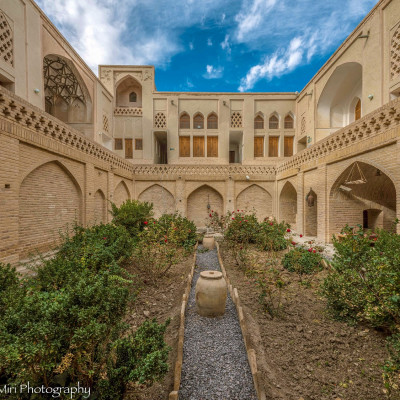
Kavir-e Naeen Ethnography Museum
Kavir Naeen Ethnography Museum, also known as Pirnia House, is located in the city of Naeen, Isfahan province. This building dates back to the Safavid era and is situated on 25 Shahrivar Street, in front of the historic Jama Mosque of Naeen. After many years, Pirnia House has been transformed into a model of historical architecture in the desert. This house was initially the residence of the city's ruler. The first owner of this building was a person named Qazi Nur al-Din, the great-grandfather of Dr. Hossein Fatemi. Mirza Ahmad Khan Pirnia, the ruler of Naeen during the Qajar period, became the next owner of this remarkable building, and the house eventually passed down to the Pirnia family.
Kavir-e Naeen Ethnography Museum is, in fact, a historical complex that encompasses several houses. Like other late Safavid and early Qajar historical houses, it has eight entrances, a Shah Neshin (a reception room for important guests), a living room, a garden well, a garden, and other indoor and outdoor sections. One of the remarkable decorations of Pirnia House is its exquisite stucco in the Shah Neshin, the throne room, and the upper viewing room. This type of stucco includes various formal, abstract, and Yazdi-Bandi motifs. It is said that the house had beautiful wall paintings of romantic stories such as Khosrow and Shirin, Yusuf and Zulaykha, and hunting scenes as well as imaginary landscapes. Persian poetry completed these views on the house walls. Other motifs in the wall paintings of Pirnia House include floral, geometric, bird, and dragon patterns. The courtyard was at a lower level than the house and was always cool.
In 1349, Pirnia's House was transferred to the Ministry of Culture and Art and was restored. Later, in 1373, it was converted into Kavir-e Naeen Ethnography Museum. The Cultural Heritage, Handicrafts and Tourism Administration of Naeen is located in this historical building. Here, historical objects or their models are displayed alongside the daily life tools of the desert people. Clothing, agricultural tools, military equipment, metal and wooden utensils, handicrafts such as Aba weaving, Kilim weaving, traditional blacksmithing, pottery, and carpet weaving are among the subjects of this remarkable museum, in addition to the traditions and customs of the ancient city of Naeen.
Old pottery jars from the Ilkhanate era, a wooden plaque from the Baba Abdullah Mosque dating back to the Ilkhanate period, and a 300-400-year-old Zilou are among the most important items displayed in this museum.
Pirnia House was registered as a national heritage of Iran with the number 995 on September 29, 1977.
